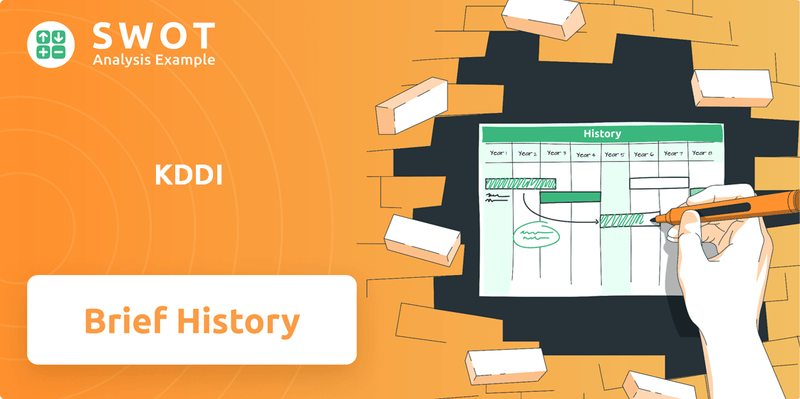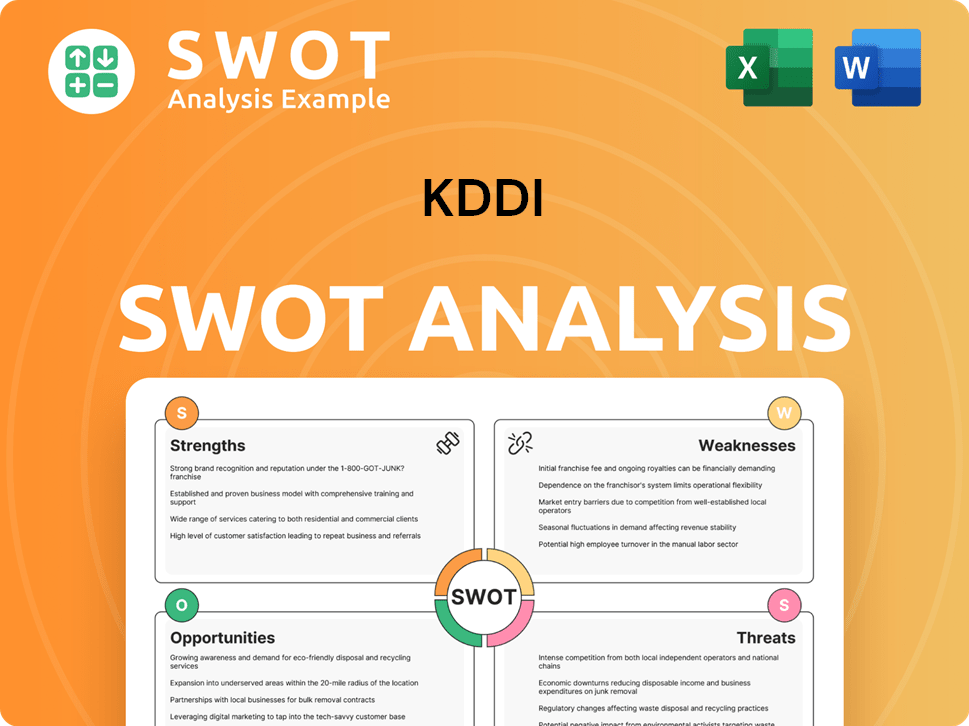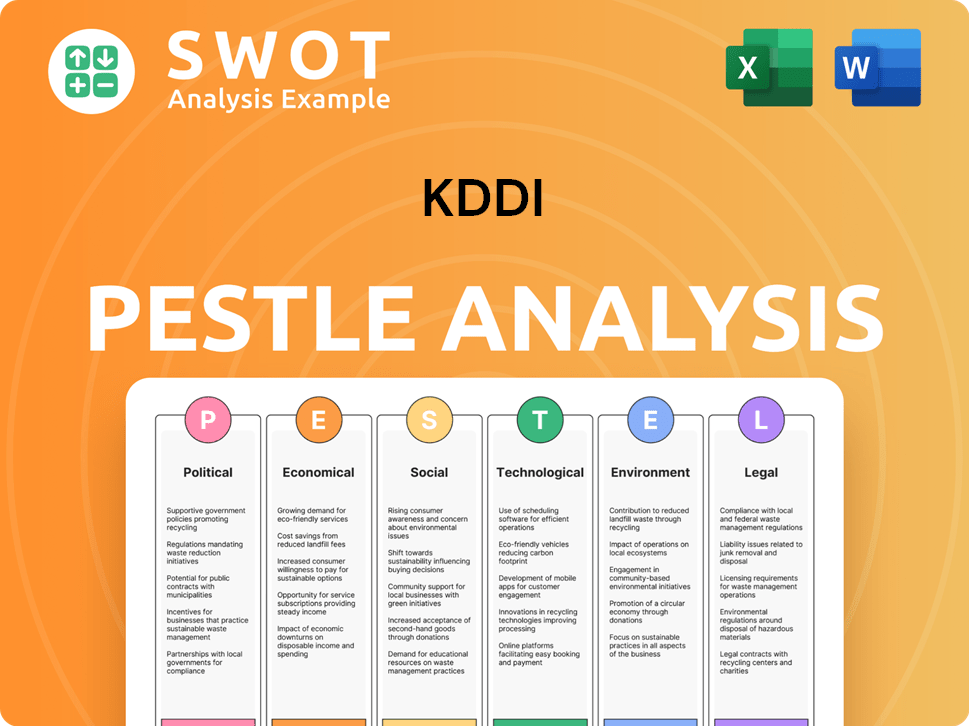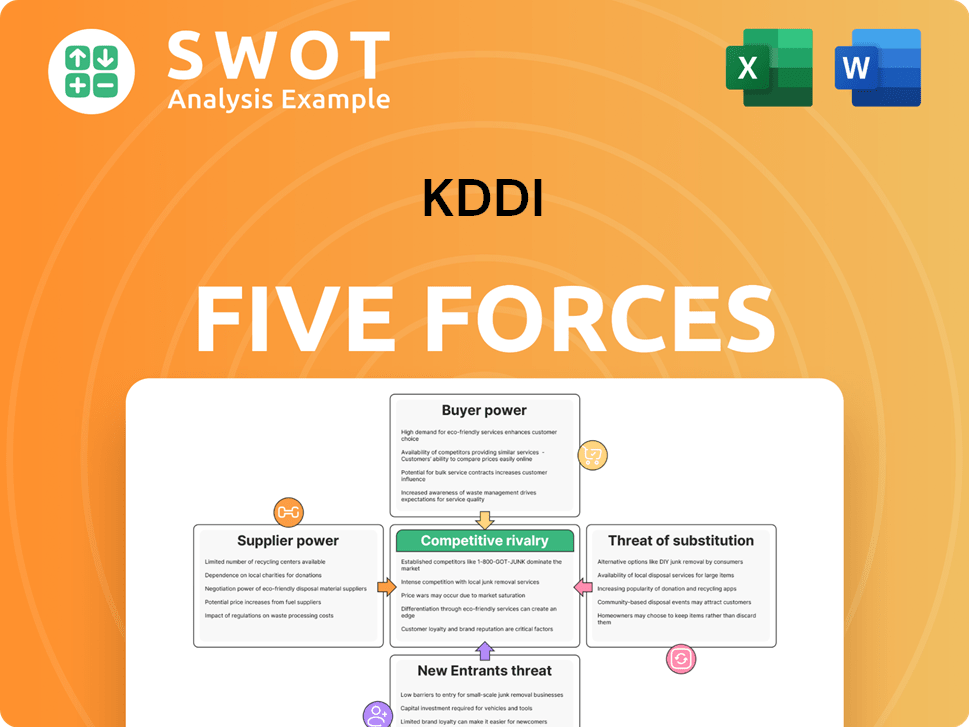KDDI Bundle
How Did KDDI Conquer the Japanese Telecom Market?
Explore the fascinating KDDI SWOT Analysis, a Japanese telecommunications giant, and discover the strategic moves that propelled it to the forefront of the Telecom industry Japan. From its inception, KDDI has navigated a complex landscape, evolving from a challenger to a dominant force. Uncover the key milestones and innovations that shaped the KDDI history and its impact on the global stage.

This brief history of KDDI corporation will delve into the KDDI company background information, tracing its roots back to the early years and development of its predecessors. Understanding KDDI's founding and evolution provides crucial context for appreciating its current market position and future aspirations. We'll also examine KDDI's key milestones, technological advancements, and its role in 5G deployment, offering insights into its lasting impact on Japanese telecommunications and beyond.
What is the KDDI Founding Story?
The story of the KDDI company begins with a pivotal moment in Japanese business history: the liberalization of the telecommunications market. This shift in the mid-1980s paved the way for competition, and from this environment, a new player emerged to challenge the established order.
The core of what would become KDDI was founded on June 1, 1984, as Daini Denden Inc. (DDI). This company was the brainchild of Kazuo Inamori, the founder of Kyocera Corporation, along with other key Japanese companies. Their collective vision was to disrupt the existing monopoly held by Nippon Telegraph and Telephone Public Corporation (NTT), which controlled the telecommunications landscape at the time.
DDI emerged as a direct response to the lack of competition and high prices in the Japanese telecom industry. The company's primary goal was to offer long-distance phone services at more competitive rates.
- DDI's initial strategy focused on providing long-distance telephone services.
- The company leveraged newly established digital networks to deliver its services.
- The name 'Daini Denden,' translating to 'Second Telephone Company,' clearly indicated its challenger status.
- Initial funding came from a consortium of over 200 companies, including Kyocera, Sony, and Mitsubishi.
The launch of DDI was a bold move, backed by a significant investment from a broad consortium of over 200 companies, including Kyocera, Sony, and Mitsubishi. This widespread support highlighted the strong desire within Japan for a more competitive telecommunications market. The economic climate of the time, marked by rapid growth and increasing demand for efficient communication infrastructure, created an ideal environment for DDI's entry.
DDI's initial focus was on long-distance services, a strategic move to challenge NTT's dominance. The company's success in offering competitive rates and leveraging digital networks set the stage for its future growth and evolution within the Japanese telecommunications sector. The early years were crucial in establishing DDI's presence and laying the foundation for its expansion and impact on the telecom industry in Japan.
KDDI SWOT Analysis
- Complete SWOT Breakdown
- Fully Customizable
- Editable in Excel & Word
- Professional Formatting
- Investor-Ready Format

What Drove the Early Growth of KDDI?
The early growth and expansion of the KDDI company are best understood through the evolution of its founding entities. These companies, DDI, KDD, and IDO, each played a crucial role before their merger in 2000. This consolidation was a strategic move to create a formidable player in the Japanese telecommunications market.
DDI, established in 1984, quickly challenged NTT by offering long-distance telephone services at lower rates. Early services included voice and data transmission, helping it gain a foothold in the market. In the early 1990s, DDI expanded into mobile communications through DDI Cellular, diversifying its offerings beyond fixed-line services.
Kokusai Denshin Denwa Co., Ltd. (KDD), founded in 1953, was Japan's international telecommunications carrier. KDD specialized in international voice and data services, supported by extensive submarine cable networks. This focus on global connectivity was critical for Japan's international communications needs.
IDO Corporation (Nippon Ido Tsushin), established in 1987, was a mobile phone operator in the Kanto and Tokai regions. IDO's growth was driven by increasing demand for mobile communication, competing directly with NTT Docomo. The expansion of mobile services was a key trend in the late 1990s.
The merger of DDI, KDD, and IDO in October 2000 created KDDI Corporation, a comprehensive telecommunications provider. This merger allowed KDDI to offer integrated mobile, fixed-line, and international services. The combined entity leveraged the strengths of its predecessors to compete effectively against NTT, significantly shaping its trajectory. In 2024, KDDI continues to be a major player in the Japanese telecom industry, with a focus on 5G deployment and expanding its global presence.
KDDI PESTLE Analysis
- Covers All 6 PESTLE Categories
- No Research Needed – Save Hours of Work
- Built by Experts, Trusted by Consultants
- Instant Download, Ready to Use
- 100% Editable, Fully Customizable

What are the key Milestones in KDDI history?
The KDDI history is marked by significant milestones, from its formation through mergers to its advancements in the Japanese telecommunications industry. These milestones reflect the company's adaptability and strategic vision in a competitive market.
| Year | Milestone |
|---|---|
| 1984 | Daini Denden Inc. (DDI) is established, marking the initial entry into the Japanese telecom market. |
| 1985 | International Digital Communications (IDC) is founded, focusing on international telecommunications. |
| 1996 | IDO Corporation is established, focusing on mobile phone services. |
| 2000 | DDI, KDD, and IDO merge to form KDDI Corporation, creating a comprehensive telecommunications provider. |
| Early 2000s | KDDI launches its 'au' brand, aggressively promoting 3G mobile technology and gaining market share. |
| 2010s | KDDI invests heavily in its 4G LTE network, expanding high-speed mobile data services across Japan. |
| 2020s | KDDI focuses on 5G deployment, aiming for substantial population coverage and expanding into IoT, AI, and financial services. |
KDDI has consistently been at the forefront of technological advancements, particularly in mobile communications. The company has pioneered advanced mobile internet services and is currently leading in 5G deployment.
KDDI was an early adopter and promoter of 3G mobile technology, which significantly boosted its market share. This early move helped establish KDDI as a key player in the Telecom industry Japan.
KDDI was a pioneer in offering advanced mobile internet services, including email and web browsing on mobile phones. This innovation set the stage for the widespread adoption of smartphones.
Substantial investments in its 4G LTE network provided high-speed mobile data services across Japan. This investment improved the overall customer experience.
KDDI is at the forefront of 5G deployment, aiming for substantial population coverage by 2025. This includes expanding into IoT, AI, and financial services.
KDDI has been actively developing IoT solutions for various industries. This diversification is a key strategic move.
KDDI has pursued strategic partnerships and acquisitions to strengthen its ecosystem. This includes collaboration with Lawson on digital transformation initiatives.
KDDI has faced several challenges, including intense competition and the need to adapt to technological shifts. These challenges have driven the company to continuously innovate and diversify its services.
KDDI faces intense competition from NTT Docomo and SoftBank, leading to price wars and the necessity for continuous innovation. This competition is a constant factor in the telecom industry.
Market downturns, such as the global financial crisis, impacted consumer spending on telecommunications services. This required KDDI to adapt its strategies.
Adapting to the rapid shift from feature phones to smartphones presented a significant hurdle, requiring substantial investment in network infrastructure. This change demanded new service offerings.
A notable internal challenge involved integrating the diverse corporate cultures of DDI, KDD, and IDO post-merger. This integration was critical for unified operations.
Economic factors, such as fluctuations in consumer spending, have influenced KDDI's financial performance. KDDI's financial performance is impacted by these factors.
The rapid pace of technological advancements requires continuous investment and adaptation. KDDI must stay ahead of the curve to maintain its competitive edge.
KDDI Business Model Canvas
- Complete 9-Block Business Model Canvas
- Effortlessly Communicate Your Business Strategy
- Investor-Ready BMC Format
- 100% Editable and Customizable
- Clear and Structured Layout

What is the Timeline of Key Events for KDDI?
The KDDI history reflects a strategic evolution from a challenger to a leading Japanese telecommunications provider. Starting as Daini Denden Inc. (DDI) in 1984, the company challenged NTT's monopoly, and expanded into mobile communications with IDO Corporation. The merger of DDI, KDD, and IDO in 2000 formed KDDI Corporation, marking a pivotal moment. Subsequent years saw the launch of the 'au' brand, significant 4G LTE network investments, and diversification into cable television, broadband, and energy, shaping KDDI's current market position.
| Year | Key Event |
|---|---|
| June 1, 1984 | Daini Denden Inc. (DDI) was established, beginning the challenge to NTT's monopoly. |
| 1987 | IDO Corporation (Nippon Ido Tsushin) was founded, entering the mobile communication market. |
| October 1, 2000 | DDI, KDD, and IDO merged to form KDDI Corporation, creating a comprehensive telecommunications provider. |
| 2002 | Launch of 'au' brand 3G services, becoming a leader in mobile internet. |
| 2010s | Significant investment and expansion of 4G LTE network across Japan. |
| 2013 | Acquisition of Jupiter Telecommunications (J:COM) shares, expanding into cable television and broadband. |
| 2015 | Launch of 'au Denki' (electricity service), diversifying into energy. |
| 2020 | Accelerated deployment of 5G services nationwide. |
| 2022 | Announced 'KDDI VISION 2030,' outlining long-term strategic goals for a sustainable society. |
| 2023 | Partnership with Starlink to provide satellite broadband services in remote areas. |
| 2024-2025 | Continued focus on 'next-generation communication infrastructure' and 'data-driven management.' |
KDDI's 'VISION 2030' outlines its commitment to a 'Resilient Future Society'. This plan focuses on leveraging telecommunications to address societal challenges. Key areas include sustainability and creating new value beyond traditional telecommunications. This vision guides KDDI's strategic direction, emphasizing innovation and social responsibility.
KDDI is actively expanding its 5G network and preparing for 6G. This expansion is crucial for supporting advanced applications and services. Investments in infrastructure are ongoing to meet the growing demand for high-speed connectivity. The company aims to enhance network capabilities to support emerging technologies.
KDDI is developing cutting-edge IoT solutions and integrating AI. These technologies are aimed at creating new services and improving operational efficiencies. The company is focusing on data-driven management to enhance decision-making. This approach supports innovation and improves customer experiences.
KDDI is expanding its 'Life Transformation (LX)' business, integrating telecommunications with daily life. This includes services in finance, healthcare, and entertainment. The goal is to create a more connected and convenient lifestyle for customers. This expansion supports the company's diversification strategy.
KDDI Porter's Five Forces Analysis
- Covers All 5 Competitive Forces in Detail
- Structured for Consultants, Students, and Founders
- 100% Editable in Microsoft Word & Excel
- Instant Digital Download – Use Immediately
- Compatible with Mac & PC – Fully Unlocked

Related Blogs
- What is Competitive Landscape of KDDI Company?
- What is Growth Strategy and Future Prospects of KDDI Company?
- How Does KDDI Company Work?
- What is Sales and Marketing Strategy of KDDI Company?
- What is Brief History of KDDI Company?
- Who Owns KDDI Company?
- What is Customer Demographics and Target Market of KDDI Company?
Disclaimer
All information, articles, and product details provided on this website are for general informational and educational purposes only. We do not claim any ownership over, nor do we intend to infringe upon, any trademarks, copyrights, logos, brand names, or other intellectual property mentioned or depicted on this site. Such intellectual property remains the property of its respective owners, and any references here are made solely for identification or informational purposes, without implying any affiliation, endorsement, or partnership.
We make no representations or warranties, express or implied, regarding the accuracy, completeness, or suitability of any content or products presented. Nothing on this website should be construed as legal, tax, investment, financial, medical, or other professional advice. In addition, no part of this site—including articles or product references—constitutes a solicitation, recommendation, endorsement, advertisement, or offer to buy or sell any securities, franchises, or other financial instruments, particularly in jurisdictions where such activity would be unlawful.
All content is of a general nature and may not address the specific circumstances of any individual or entity. It is not a substitute for professional advice or services. Any actions you take based on the information provided here are strictly at your own risk. You accept full responsibility for any decisions or outcomes arising from your use of this website and agree to release us from any liability in connection with your use of, or reliance upon, the content or products found herein.